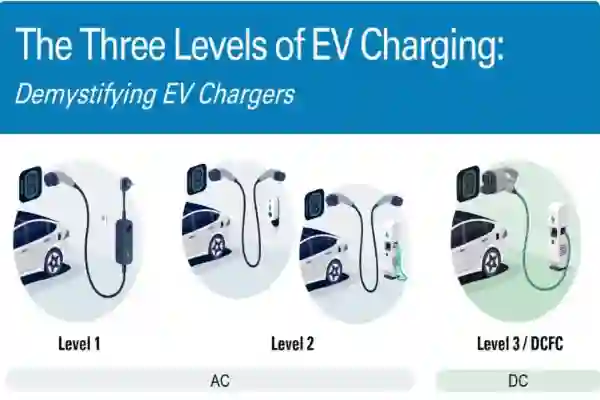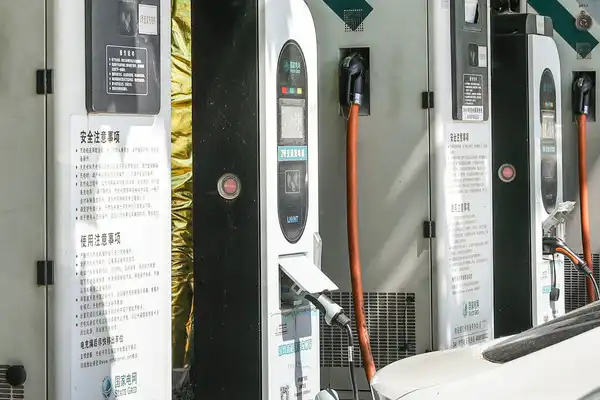Differences Between Level 1, Level 2, and Level 3 EV Charging
The rapid adoption of electric vehicles (EVs) has spurred demand for accessible and efficient charging infrastructure. Central to this infrastructure are charging stations categorized into three distinct levels: Level 1, Level 2, and Level 3 (also known as DC Fast Charging). Each level differs in power output, charging speed, installation requirements, cost, and application. For businesses, policymakers, and EV owners, understanding these differences is critical to optimizing charging solutions for residential, commercial, and public use. This article explores the technical specifications, use cases, advantages, and limitations of each charging level, providing a comprehensive guide to navigating the evolving EV ecosystem.

Level 1 Charging: Basic Charging for Everyday Use
Technical Specifications
- Voltage: 120 volts (standard household outlet).
- Current: 12–16 amps.
- Power Output: 1.4 kW to 1.9 kW.
- Charging Speed: Adds 3–5 miles of range per hour.
How It Works
Level 1 charging uses a standard 120V AC outlet, requiring no specialized equipment beyond the portable charging cord typically included with EVs. It delivers power directly to the vehicle’s onboard charger, which converts AC to DC to replenish the battery.
Use Cases
- Residential Charging: Ideal for homeowners who drive short daily distances (e.g., 30–40 miles) and can charge overnight.
- Emergency Backup: Useful as a secondary charging option during travel or power outages.
Advantages
- Low Cost: Requires no installation fees beyond a standard outlet.
- Portability: The charger can be used anywhere with a 120V outlet.
- Simplicity: Minimal technical expertise needed for operation.
Limitations
- Slow Charging: Unsuitable for long-distance travel or high-mileage drivers.
- Inefficiency: Prolonged charging times may strain household circuits.
Level 2 Charging: The Standard for Home and Public Charging
Technical Specifications
- Voltage: 208–240 volts (similar to large appliances like dryers).
- Current: 15–80 amps.
- Power Output: 3.3 kW to 19.2 kW.
- Charging Speed: Adds 12–80 miles of range per hour.
How It Works
Level 2 chargers utilize 240V AC power, requiring a dedicated circuit and professional installation. They bypass the vehicle’s onboard charger by delivering higher power directly to the battery, significantly reducing charging times compared to Level 1.
Use Cases
- Residential Charging: Preferred by EV owners needing faster overnight charging.
- Commercial/Public Charging: Deployed at workplaces, shopping centers, parking garages, and multifamily housing.
- Fleet Charging: Supports delivery vehicles, taxis, and corporate EV fleets.
Advantages
- Speed: Charges 3–10x faster than Level 1.
- Versatility: Compatible with most EVs and widely adopted in public networks.
- Smart Features: Many Level 2 stations offer Wi-Fi connectivity, scheduling, and energy monitoring.
Limitations
- Installation Costs: Requires a 240V circuit, which may cost 500–500–2,000 depending on electrical upgrades.
- Power Limitations: Still insufficient for ultra-fast charging demands (e.g., long-haul travel).
Level 3 Charging (DC Fast Charging): The Highway Charging Solution
Technical Specifications
- Voltage: 400–900 volts (direct current).
- Current: 100–500 amps.
- Power Output: 50 kW to 350 kW.
- Charging Speed: Adds 60–300 miles of range in 20–30 minutes.
How It Works
Level 3 chargers bypass the vehicle’s onboard charger entirely, delivering high-voltage DC power directly to the battery. This eliminates the AC/DC conversion bottleneck, enabling ultra-fast charging. Common standards include CCS (Combined Charging System), CHAdeMO, and Tesla Supercharger.
Use Cases
- Highway Corridors: Critical for long-distance travel, often located near highways.
- Urban Hubs: Deployed in high-traffic areas like gas stations, rest stops, and city centers.
- Commercial Fleets: Supports rapid turnover for ride-sharing or delivery services.
Advantages
- Ultra-Fast Charging: Ideal for drivers needing quick top-ups during trips.
- Scalability: High-power stations support multiple vehicles simultaneously.
- Future-Proofing: 350 kW chargers accommodate next-gen EVs with larger batteries.
Limitations
- High Costs: Installation ranges from 50,000to50,000to150,000 per station.
- Battery Stress: Frequent use of DC fast charging may degrade battery health over time.
- Compatibility Issues: Not all EVs support all standards (e.g., Tesla requires adapters for CCS).
Comparative Analysis: Level 1 vs. Level 2 vs. Level 3
| Criteria | Level 1 | Level 2 | Level 3 (DC Fast) |
|---|---|---|---|
| Power Source | 120V AC | 208–240V AC | 480V+ DC |
| Charging Speed | 3–5 miles/hour | 12–80 miles/hour | 60–300 miles/20–30 minutes |
| Installation Cost | 0–0–300 | 500–500–2,000 | 50,000–50,000–150,000 |
| Typical Locations | Homes | Homes, workplaces, malls | Highways, urban hubs |
| Use Case | Overnight charging | Daily use, public networks | Long-distance travel |
| Battery Impact | Minimal degradation | Moderate degradation | Potential long-term degradation |
Key Considerations for Choosing a Charging Level
- Driving Habits: Level 1 suits low-mileage drivers; Level 2 is ideal for daily commuters; Level 3 caters to road-trippers.
- Infrastructure Costs: Level 3 requires significant upfront investment but offers higher ROI in high-traffic areas.
- Vehicle Compatibility: Confirm charging standards (e.g., CCS, CHAdeMO) match the EV’s capabilities.
- Energy Grid Capacity: Level 3 stations demand robust grid connections and may require onsite energy storage.
The Role of Charging Levels in the EV Ecosystem
- Residential Adoption: Level 1 and Level 2 dominate home charging, with Level 2 becoming the default for new EV owners.
- Commercial Networks: Level 2 stations are the backbone of workplace and retail charging, while Level 3 stations target highway and urban corridors.
- Policy Implications: Governments incentivize Level 2 and Level 3 deployments to reduce range anxiety and accelerate EV adoption.
Future Trends in EV Charging Technology
- Bidirectional Charging: Level 2 and Level 3 stations enabling vehicle-to-grid (V2G) energy transfer.
- Ultra-Fast Charging: 350 kW+ chargers becoming standard for next-gen EVs.
- Renewable Integration: Solar-powered stations and battery buffers reducing grid dependency.
Conclusion
The distinction between Level 1, Level 2, and Level 3 charging lies at the heart of EV infrastructure planning. While Level 1 offers simplicity and affordability, Level 2 strikes a balance between speed and accessibility for daily use. Level 3, though costly, is indispensable for long-distance travel and commercial viability. As EV technology advances, the interplay between these charging levels will shape the accessibility, sustainability, and scalability of electric mobility. For businesses and policymakers, investing in the right mix of charging solutions—tailored to regional needs and user behavior—will be pivotal in driving the global transition to electric transportation.

